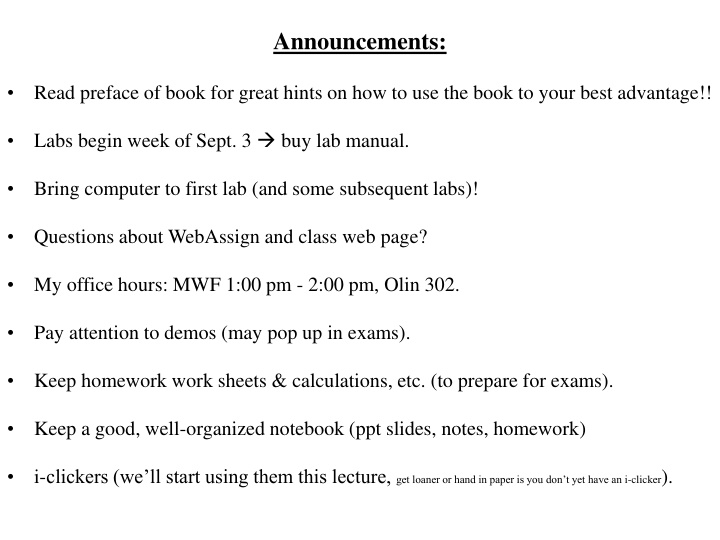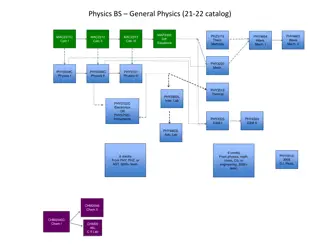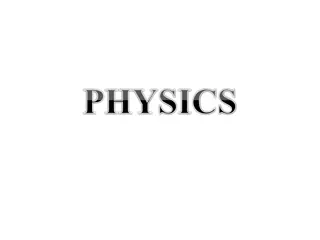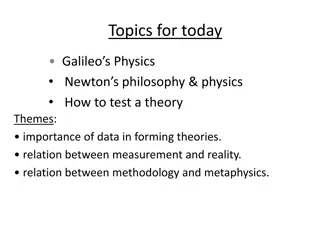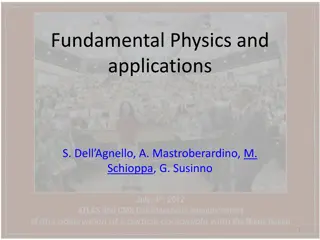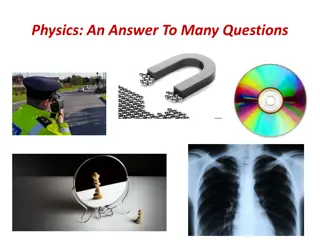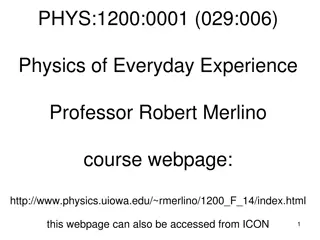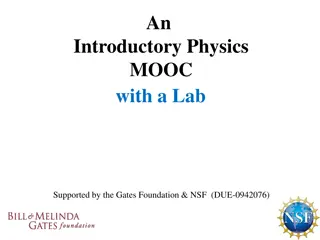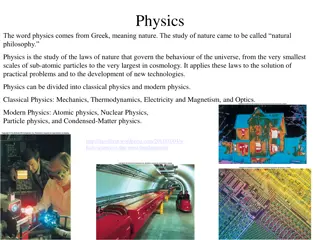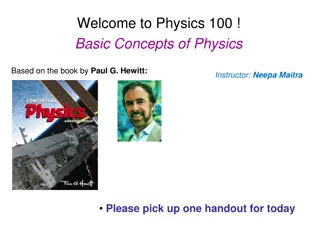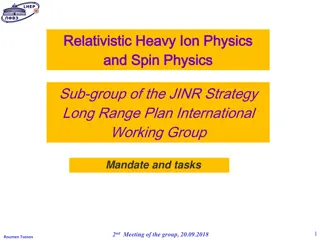Physics 113 Course Updates and Study Guidelines
Important announcements and instructions for Physics 113 students, including details on lab sessions, tutoring opportunities, reading assignments, and concepts related to motion in one dimension. Make the most of resources provided for successful learning.
Download Presentation

Please find below an Image/Link to download the presentation.
The content on the website is provided AS IS for your information and personal use only. It may not be sold, licensed, or shared on other websites without obtaining consent from the author.If you encounter any issues during the download, it is possible that the publisher has removed the file from their server.
You are allowed to download the files provided on this website for personal or commercial use, subject to the condition that they are used lawfully. All files are the property of their respective owners.
The content on the website is provided AS IS for your information and personal use only. It may not be sold, licensed, or shared on other websites without obtaining consent from the author.
E N D
Presentation Transcript
Announcements: Read preface of book for great hints on how to use the book to your best advantage!! Labs begin week of Sept. 3 buy lab manual. Bring computer to first lab (and some subsequent labs)! Questions about WebAssign and class web page? My office hours: MWF 1:00 pm - 2:00 pm, Olin 302. Pay attention to demos (may pop up in exams). Keep homework work sheets & calculations, etc. (to prepare for exams). Keep a good, well-organized notebook (ppt slides, notes, homework) i-clickers (we ll start using them this lecture, get loaner or hand in paper is you don t yet have an i-clicker).
PHY113 TUTOR SESSIONS Sun day - Monday Tuesday Wednesday Thursday Friday Saturday 6-8 pm 5-7 pm 5-7 pm 5-7 pm - - Daniel Vickers Daniel Vickers Daniel Vickers Daniel Vickers All tutorials will be in Olin 103 The tutor sessions in semesters past were very successful and received high marks from many students. All students are encouraged to take advantage of this opportunity.
Chapter 2: Motion in One Dimension Reading assignment: Chapter 2 Homework 2.1 (due Thursday, Sept. 6): OQ1, 1, 4, 7 Homework 2.2 (due Tuesday, Sept. 11): OQ17, OQ18, 19, 20, 28, 35, 51, 72 (OQ objective question, (concept) QQ Quick quiz) Kinematics: motion in terms of space and time (position, x; velocity, v; acceleration, a). We ll mainly deal with constant acceleration. dx v dt dv dt = = Derivatives: ; a In this chapter we will only look at motion in one dimension.
Position, Displacement and distance traveled Position: Location of particle with respect to some reference point. Displacement of a particle: xf final position x x x Its change in position: f i xi: initial position Don t confuse displacement with the distance traveled. Example: What is the displacement and the total distance traveled of a baseball player hitting a homerun? Displacement is a vector: It has both, magnitude and direction!! Total distance traveled is a scalar: It has just a magnitude
Velocity and speed Average Velocity of a particle: x vx x: displacement of particle t t: total time during which displacement occurred. Average speed of a particle: total distance = average speed total time Velocity is a vector: It has both, magnitude and direction!! Speed is a scalar: It has just a magnitude
Blackboard example 2.1: The position of a car is measured every ten seconds relative to zero. A) 30 m B) 52 m C) 38 m D) 0 m E) - 37 m F) -53 m Find the displacement, average velocity and average speed between positions A and F.
Instantaneous velocity and speed x dx = lim v x t dt 0 t Instantaneous velocity is the derivative of x with respect to t, dx/dt! Velocity is the slope of a position-time graph! The (instantaneous) speed (scalar) is defined as the magnitude of its (instantaneous) velocity (vector)
10 Blackboard example 2.2 8 displacement (m) 6 A particle moves along the x-axis. Its coordinate varies with time according to the expression: 4 x 2 0 t 2 m m = 4 ( 2 ( + -2 ) ) x t t s 2 s -4 0 0.5 1 1.5 2 2.5 3 3.5 4 time (s) (a) Determine the displacement of the particle in the time intervals t=0 to t=1s and t=1s to t=3s. (b) Calculate the average velocity during these two time interval. (c) Find the instantaneous velocity of the particle at t = 2.5s. (d)i-clicker: What is the instantaneous velocity at 1s (graph)? A.) 0 m/s B.) 0.5 m/s C.) 1 m/s D.) indeterminate
Acceleration When the velocity of a particle (say a car) is changing, it is accelerating (can be positive or negative). The average acceleration of the particle is defined as the change in velocity vx divided by the time interval t during which that change occurred. v v v xf t xi = x a x t t f i
Acceleration The instantaneous acceleration equals the derivative of the velocity with respect to time (slope of velocity vs. time graph). v dv = lim x x a x Units: m/sec2 t dt 0 t Because vx = dx/dt, the acceleration can also be written as: 2 dv d dx d x = = x a x 2 dt dt dt dt
Worksheet Find the corresponding acceleration vs. time graphs parabola
Conceptual black board example 2.3 Relationship between acceleration-time graph and velocity-time graph and displacement-time graph.
Notice that acceleration and velocity often point in different directions
One-dimensional motion with constant acceleration, kinematic equations = + v v a t *Velocity as function of time xf xi x = + + 1 ( ) x x v v t Position as function of time and velocity f i xi xf 2 1 = + + 2 x x v t a t *Position as function of time f i xi x 2 2 2 = + 2 ( ) v v a x x Velocity as function of position xf xi x f i These four kinematic equations can be used to solve any problem involving one-dimensional motion at constant acceleration. Derivations: Book, chapter 2
Black board example 2.4 The driver of a car slams on the brakes when he sees a tree blocking the road. The car slows uniformly with an acceleration of 5.60 m/s2 for 4.2s, making skid marks 62.4 m long ending at the tree. With what speed does the car then strike the tree?
Freely falling objects In the absence of air resistance, all objects fall towards the earth with the same constant acceleration (a = - g = - 9.8 m/s2), due to gravity. http://upload.wikimedia.org/wikipedia/commons/thumb/d/d4/Justus_Sustermans_-_Portrait_of_Galileo_Galilei%2C_1636.jpg/225px-Justus_Sustermans_-_Portrait_of_Galileo_Galilei%2C_1636.jpg i-clicker: You throw a ball straight up in the air. At the highest point, what are the velocity and the acceleration of the ball? A.) a = 0; v = 0 B.) a = - 9.8m/s2v 0 Galileo Galilei (1564-1642) (from Wikipedia) C.) a = - 9.8m/s2 v = 0
Black board example 2.5 A stone thrown from the top of a building is given an initial velocity of 20.0 m/s straight upward. The building is 50 m high. Using tA = 0 as the time the stone leaves the throwers hand at position A, determine: (a) The time at which the stone reaches its maximum height. (b) The maximum height. (c) The time at which the stone returns to the position from which it was thrown. (d) The velocity of the stone at this instant (e) The velocity and and position of the stone at t = 5.00 s. (f) Plot y vs. t; v vs. t and a vs. t
Chapter summary Position x, velocity v, acceleration a Acceleration is derivative of v and 2nd derivative of x: a = dv/dt = d2x/dt2, and v = dx/dt. Know x, v, a graphs. v is slope of x vs. t graph, a is slope of v vs. t graph. Kinematic equations on page 36-38 (constant acceleration). Know how to use! Do many practice examples. Free fall (constant acceleration)
